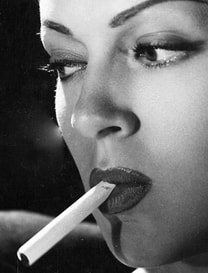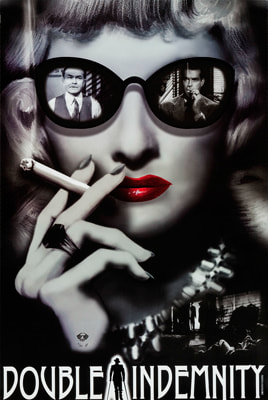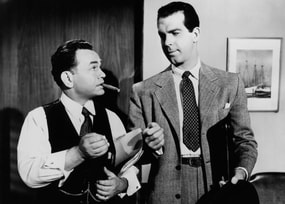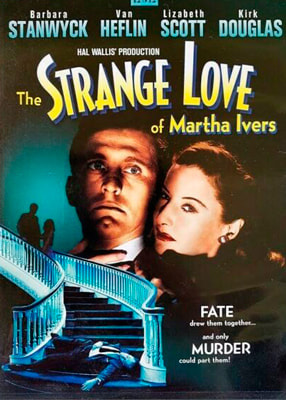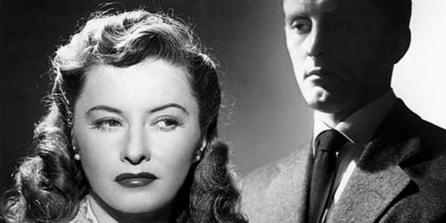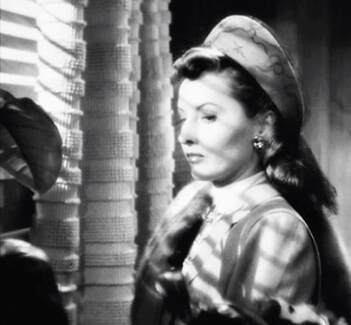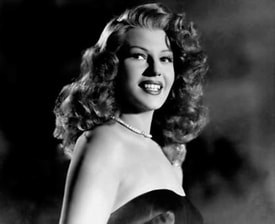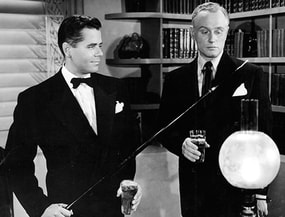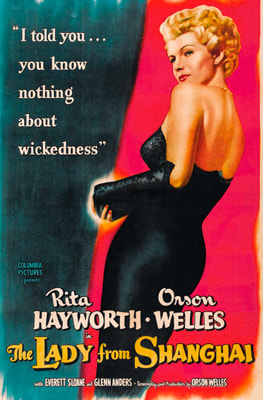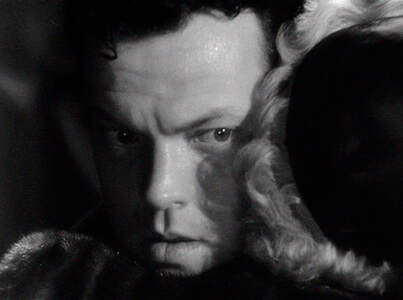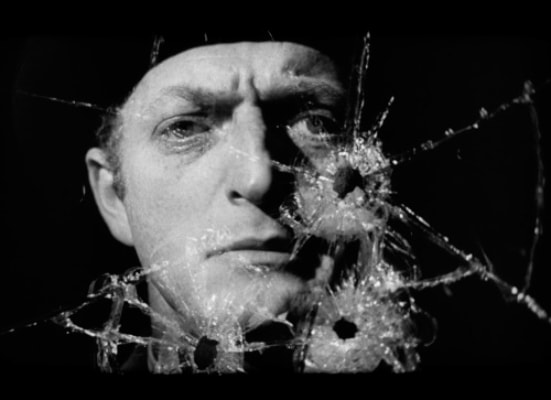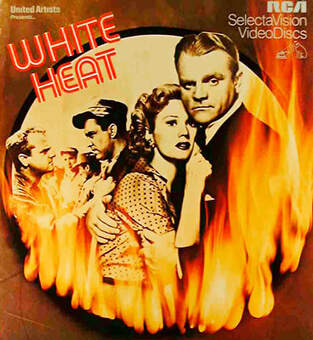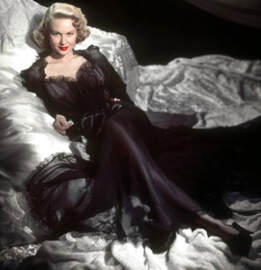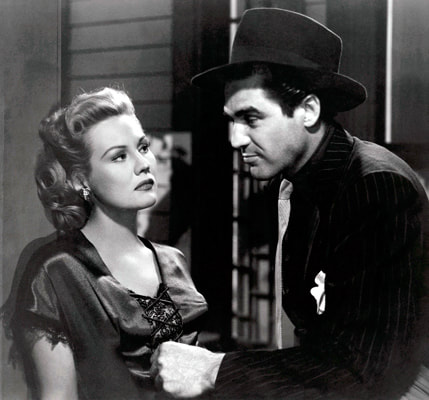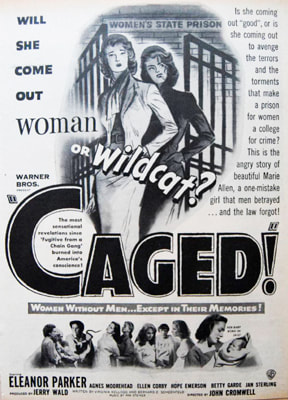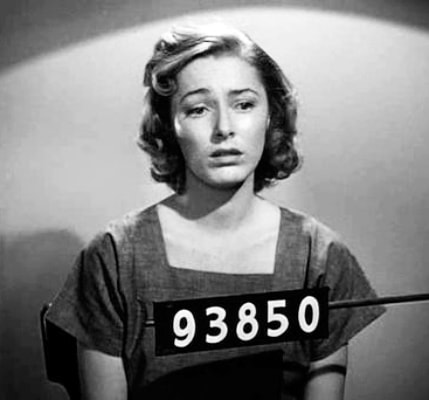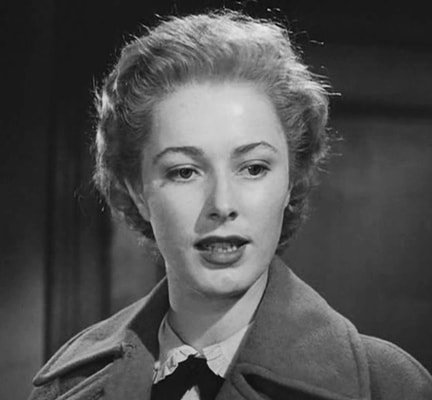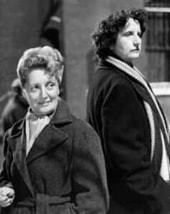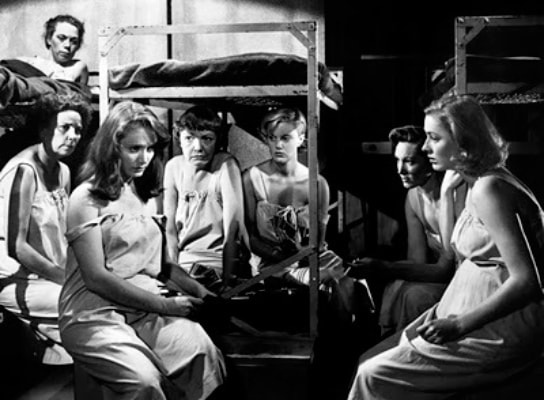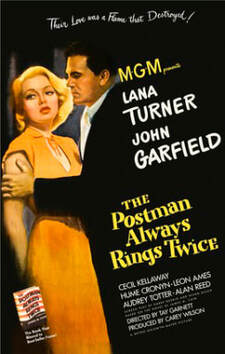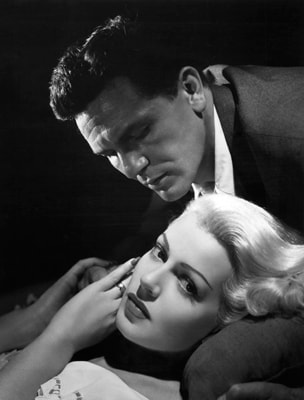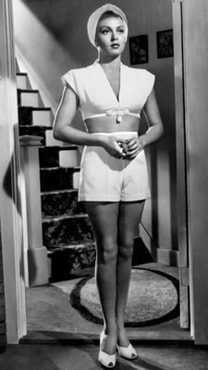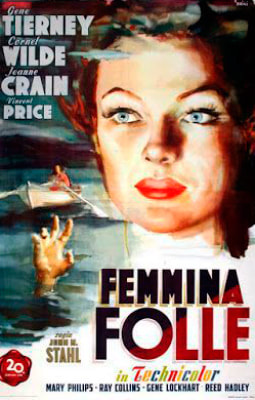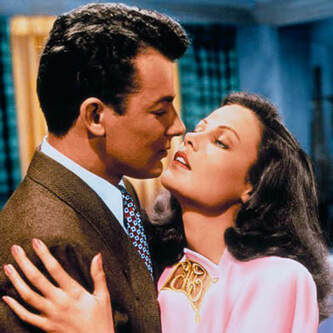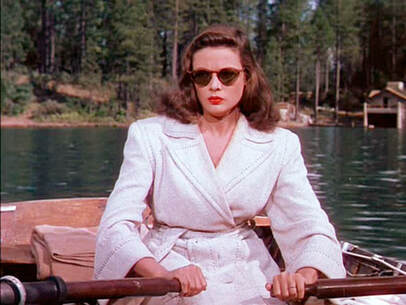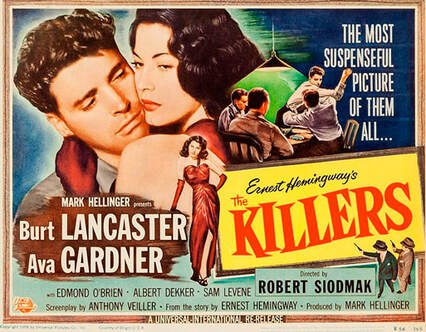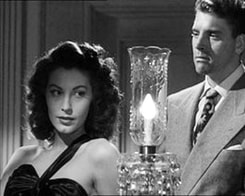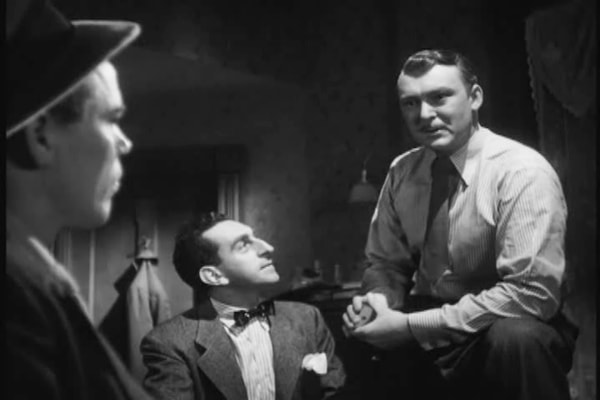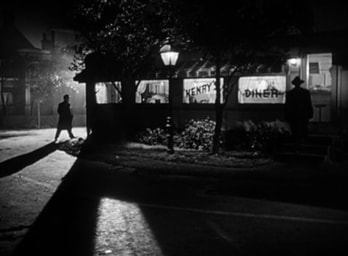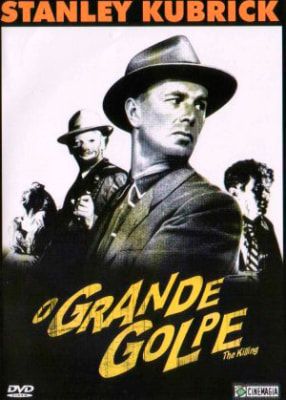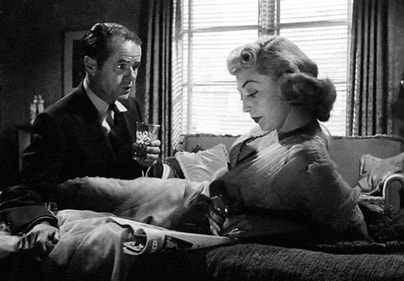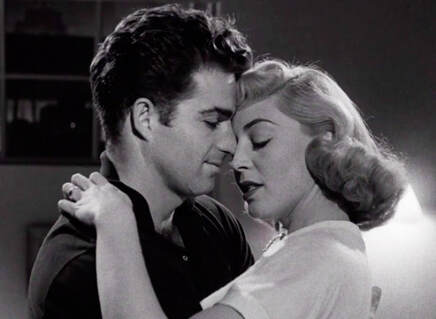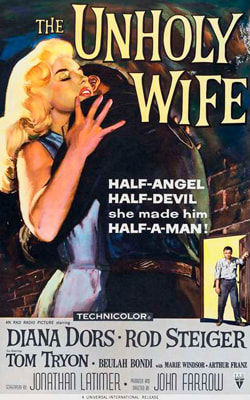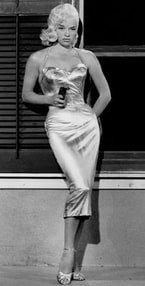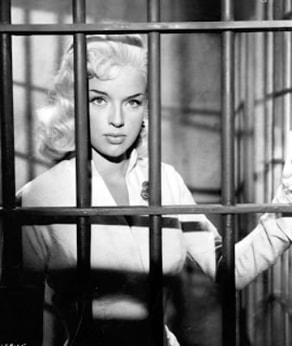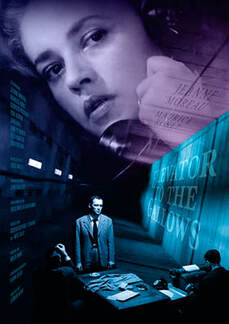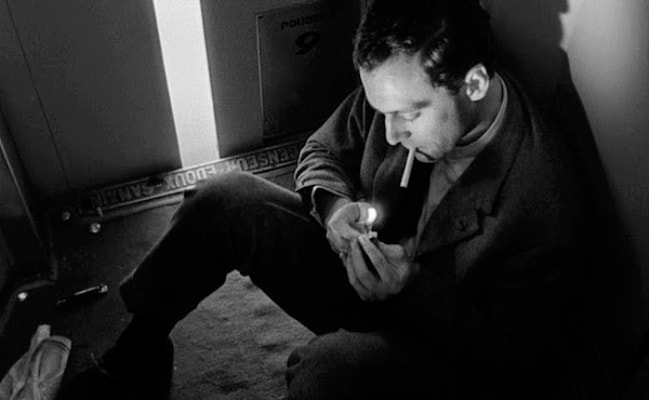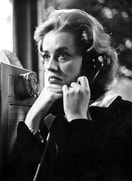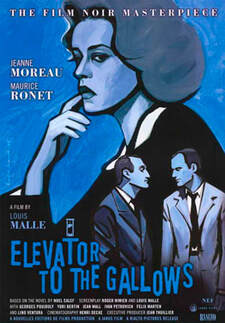Femme Fatales: Honey, I'm Home!
Marriage? Kids? - Are you kidding me?
* PART ONE *
Marriage? Kids? - Are you kidding me?
* PART ONE *
By Paulette Reynolds * July 5, 2021
Marriage? Kids? In NoirLand, it's complicated for a wife or stepmother. CineMata celebrates the Femme Fatale, who traded societal expectations for empowerment - and lots of it!
Barbara Stanwyck
Barbara shines in two of NoirLand's favorite femme Fatales - Phyllis Dietrichson and Martha Ivers.
Double Indemnity * 1944
Phyllis has the distinction of being one of the few noir wives to have worked before settling into wedded regret with a rich industrialist - but not before knocking off the first Mrs. Dietrichson (“allegedly").
She's also saddled with a stepdaughter, but that doesn't slow Phyllis down one bit. The first credo of the Femme is "to thine own self be selfish", and she rides that train all the way to a dead end - but not before getting insurance agent Walter Neff to knock off her husband. The second credo is to always have a plan B, which usually involves yet another sucker - and the good widow taps her step daughter’s boyfriend as a potential playmate.
Barbara shines in two of NoirLand's favorite femme Fatales - Phyllis Dietrichson and Martha Ivers.
Double Indemnity * 1944
Phyllis has the distinction of being one of the few noir wives to have worked before settling into wedded regret with a rich industrialist - but not before knocking off the first Mrs. Dietrichson (“allegedly").
She's also saddled with a stepdaughter, but that doesn't slow Phyllis down one bit. The first credo of the Femme is "to thine own self be selfish", and she rides that train all the way to a dead end - but not before getting insurance agent Walter Neff to knock off her husband. The second credo is to always have a plan B, which usually involves yet another sucker - and the good widow taps her step daughter’s boyfriend as a potential playmate.
Walter Neff: You know, about six months ago, a guy slipped on a cake of soap in his bathtub, knocked himself cold, and was drowned. Only, he had accident insurance, so they had an autopsy, and she didn't get away with it.
Phyllis: Who didn’t?
Walter Neff: His wife. Then there was the case of the guy who was found shot. His wife said he was cleaning his gun and his stomach got in the way. All she got was a 3-to-10 stretch in Tehachapi.
Phyllis: [Wearily] Perhaps it was worth it to her.
Phyllis: Who didn’t?
Walter Neff: His wife. Then there was the case of the guy who was found shot. His wife said he was cleaning his gun and his stomach got in the way. All she got was a 3-to-10 stretch in Tehachapi.
Phyllis: [Wearily] Perhaps it was worth it to her.
The Strange Love of Martha Ivers * 1946
Babs stars in what was my first introduction to the mean streets and the femme fatale aesthetic, and I haven't been the same since. Nowhere is this more evident than in the noir masterpiece, The Strange Love of Martha Ivers.
Martha enjoys unlimited power as the town boss, saddled with a lovesick husband (Kirk Douglas in his film debut), a torch for Van Heflin and a deadly secret. *1
Babs stars in what was my first introduction to the mean streets and the femme fatale aesthetic, and I haven't been the same since. Nowhere is this more evident than in the noir masterpiece, The Strange Love of Martha Ivers.
Martha enjoys unlimited power as the town boss, saddled with a lovesick husband (Kirk Douglas in his film debut), a torch for Van Heflin and a deadly secret. *1
Martha Ivers: It would have been so different if you hadn't run away. It would have been you instead of Walter. Or if you had stopped me.
American film noir, which began (more or less) in the 1940s, contains a special philosophy all of its own, that is expressed vis-à-vis certain recognizable features: A shady endeavor ("the job"), a crooked thug ("the boss"), a man with a weak spot ("the fall guy"), and of course, an unscrupulous woman ("the dame").
Rita Hayworth
Gilda * 1946
Gilda swings wildly between unrequited love (for old flame Johnny, aka Glenn Ford) and bewilderment (of her mysterious new husband Ballin) in this classic gem set in Buenos Aires, Argentina during Carnival. The tension is rather contrived between Johnny and Gilda, since they clearly love each other, but Ballin - played by George Macready - is your suave gangster with more than a passing platonic interest in Johnny. The action quickly flares up but fizzles into a hopeless melodrama, but yes - there is Gilda's magnificent "Put the Blame on Mame" number.
Gilda * 1946
Gilda swings wildly between unrequited love (for old flame Johnny, aka Glenn Ford) and bewilderment (of her mysterious new husband Ballin) in this classic gem set in Buenos Aires, Argentina during Carnival. The tension is rather contrived between Johnny and Gilda, since they clearly love each other, but Ballin - played by George Macready - is your suave gangster with more than a passing platonic interest in Johnny. The action quickly flares up but fizzles into a hopeless melodrama, but yes - there is Gilda's magnificent "Put the Blame on Mame" number.
Johnny Farrell: Doesn't it bother you at all that you're married?
Gilda: What I want to know is, does it bother you?
Gilda: What I want to know is, does it bother you?
The Lady from Shanghai * 1947
While critics have excoriated Welles for his shaky Irish accent and Rita's cropped blonde hairstyle, there's no denying they crafted a compelling noir with a European aesthetic. Welles falls for the very beautiful Mrs. Elsa Bannister, who spends most of her time speaking Femme Fatale and looking gorgeous. Everett Sloane plays a bitter and crooked lawyer who must live with the knowledge that Elsa is really the only thing he can't have, but desperately can't live without. And who can forget the classic shootout in the hall of mirrors funhouse?
While critics have excoriated Welles for his shaky Irish accent and Rita's cropped blonde hairstyle, there's no denying they crafted a compelling noir with a European aesthetic. Welles falls for the very beautiful Mrs. Elsa Bannister, who spends most of her time speaking Femme Fatale and looking gorgeous. Everett Sloane plays a bitter and crooked lawyer who must live with the knowledge that Elsa is really the only thing he can't have, but desperately can't live without. And who can forget the classic shootout in the hall of mirrors funhouse?
Mrs. Elsa 'Rosalie' Bannister: I haven't a cent, Michael. He wants to cut me off without a cent.
Michael O'Hara: Does that matter so much as if he would?
Mrs. Elsa 'Rosalie' Bannister: Oh, I told you sweet, you don't know anything about the world.
Michael O'Hara: Well, lately I've been roundin' out my education.
Michael O'Hara: Does that matter so much as if he would?
Mrs. Elsa 'Rosalie' Bannister: Oh, I told you sweet, you don't know anything about the world.
Michael O'Hara: Well, lately I've been roundin' out my education.
The plot is simple: The fall guy gets caught up in a crooked scheme - and the femme's manipulative embrace - while she works her hidden agenda for getting "the goods" (usually from "the gang" and her main man). The storyline can - and usually does - have many twists and variations, but one thing is always crystal clear - the femme fatale is not ever "the little woman", "my better half", or - shudder - "mom".
In the male centered world of Noir, two of our femme favorites - White Heat and the penultimate prison masterpiece, Caged - stand out. The reason? Both are creations of Virginia Kellogg, screenwriter. Nominated for Oscars, these two stories are as different as oil and water, but they both combine to bring two frustrated femmes to their destinies in record time.
White Heat * 1949
Virginia Mayo steals every scene as the restless, dissatisfied Verna Jarrett, locked in a cage with crazed husband-on-the-run Cody (James Cagney) and his devoted Ma (Margaret Wycherly of Sergeant York fame). She wastes no time getting friendly with Big Ed (Steve Cochran) and by the film's end she proves to be poor wife, daughter-in-law, and girlfriend material.
Virginia Mayo steals every scene as the restless, dissatisfied Verna Jarrett, locked in a cage with crazed husband-on-the-run Cody (James Cagney) and his devoted Ma (Margaret Wycherly of Sergeant York fame). She wastes no time getting friendly with Big Ed (Steve Cochran) and by the film's end she proves to be poor wife, daughter-in-law, and girlfriend material.
Big Ed: What's eatin' you Sugar?
Verna Jarrett: You and your big ideas. That's all they are - ideas! "You and me belong together, Sugar. Just leave it to Big Ed." Well, I'm sick of waitin' for you to make your move. You're as scared of Cody as any of 'em. He's still Mr. Big - in prison or out.
Verna Jarrett: You and your big ideas. That's all they are - ideas! "You and me belong together, Sugar. Just leave it to Big Ed." Well, I'm sick of waitin' for you to make your move. You're as scared of Cody as any of 'em. He's still Mr. Big - in prison or out.
Caged * 1950
Poor Marie! Caught red-handed supporting her husband's illegal activities, our sweet heroine is a bit on the dim side. But leave it to the Big House - and a fascinating group of gals from the wrong side of the mean streets - to set her straight, well, straight into a life of crime, that is.
Caged is the best film about women in prison, thanks to screenwriter and author Virginia Kellogg. She pulled a few strings to get herself into several women's prisons for some first-hand research on women behind bars - which also became a story, published in Colliers magazine.
Eleanor Parker heads an unforgettable cast of women - Kitty Stark (Betty Garde) * the Boss, Elvira Powell (Lee Patrick) * the Big Boss, Evelyn Harper (Hope Emerson) * the sadistic screw, Smoochie (Jan Sterling) * the wayward girl, and Ruth Benton (Agnes Moorehead), as the honest Warden fighting a losing battle.
Marie's transformation from innocent to cynical femme will stay with you, long after Caged is over - I promise.
Poor Marie! Caught red-handed supporting her husband's illegal activities, our sweet heroine is a bit on the dim side. But leave it to the Big House - and a fascinating group of gals from the wrong side of the mean streets - to set her straight, well, straight into a life of crime, that is.
Caged is the best film about women in prison, thanks to screenwriter and author Virginia Kellogg. She pulled a few strings to get herself into several women's prisons for some first-hand research on women behind bars - which also became a story, published in Colliers magazine.
Eleanor Parker heads an unforgettable cast of women - Kitty Stark (Betty Garde) * the Boss, Elvira Powell (Lee Patrick) * the Big Boss, Evelyn Harper (Hope Emerson) * the sadistic screw, Smoochie (Jan Sterling) * the wayward girl, and Ruth Benton (Agnes Moorehead), as the honest Warden fighting a losing battle.
Marie's transformation from innocent to cynical femme will stay with you, long after Caged is over - I promise.
Marie Allen: I feel a little sick.
Infirmary Nurse: Get that way often?
Marie Allen: Yes, the last week or so.
Infirmary Nurse: Say, you expecting company?
Marie Allen: [mumbles] I don't know.
Infirmary Nurse: [cynically] Another pregnant one! Get up!... You know who the father is?
Marie Allen: My husband.
Infirmary Nurse: [sarcastically] Well, ain't we gettin' respectable! Could he help with the expenses?
Marie Allen: He's dead.
Infirmary Nurse: [with contempt] Another bill for the state! Get dressed!
Infirmary Nurse: Get that way often?
Marie Allen: Yes, the last week or so.
Infirmary Nurse: Say, you expecting company?
Marie Allen: [mumbles] I don't know.
Infirmary Nurse: [cynically] Another pregnant one! Get up!... You know who the father is?
Marie Allen: My husband.
Infirmary Nurse: [sarcastically] Well, ain't we gettin' respectable! Could he help with the expenses?
Marie Allen: He's dead.
Infirmary Nurse: [with contempt] Another bill for the state! Get dressed!
The genre of American film noir (meaning black novel) began to foreshadow the complex feelings of the post-WWII American male and what he was experiencing from the changing world around him. What set classic noir apart from your generic crime drama was the deep shadow-play cinematography, a stark fatalistic outlook and of course - the femme fatale.
The Postman Always Rings Twice * 1946
James M. Cain's story about true love brings together lust, unrequited love, and murder, served up with a little helping of blackmail and betrayal on the side. Our resident femme, Cora, is stuck in a dead-end marriage, serving burgers and fries to tourists at the roadside diner with husband Nick. The action picks up when good-looking drifter Frank chooses something that's definitely not on the menu.
Lana Turner and John Garfield make an appealing couple, trapped by their own desires and sordid deeds, who find out that NoirLand is the last place to look for true love. But who can resist Lana in white?
James M. Cain's story about true love brings together lust, unrequited love, and murder, served up with a little helping of blackmail and betrayal on the side. Our resident femme, Cora, is stuck in a dead-end marriage, serving burgers and fries to tourists at the roadside diner with husband Nick. The action picks up when good-looking drifter Frank chooses something that's definitely not on the menu.
Lana Turner and John Garfield make an appealing couple, trapped by their own desires and sordid deeds, who find out that NoirLand is the last place to look for true love. But who can resist Lana in white?
Nick Smith: [about his plan to sell Twin Oaks and move to Canada to take care of his sister] My mind's made up.
Cora Smith: So, you've given it a great deal of thought, your mind's made up? Without even talking it over with me, your mind's made up. Well, mine isn't!
Nick Smith: [coldly] That's too bad.
Cora Smith: So, you've given it a great deal of thought, your mind's made up? Without even talking it over with me, your mind's made up. Well, mine isn't!
Nick Smith: [coldly] That's too bad.
Pre-war propaganda urged mothers and single women alike to plunge into the war effort, causing fundamental changes in the family structure and community. They enjoyed the freedom to work and earn money, learn new skills, and expand their circle beyond the neighborhood. A new sense of empowerment enabled them to see farther than the one-dimensional role fashioned by society and the church.
Leave Her to Heaven * 1945
Most femme fatales just don't take to long-term commitment - and for good reason. They usually dispose of their victims without a second thought and move onto the next sucker. So when Ellen pledges to devote herself to Richard Harland, it puts a whole new meaning on "until death do we part".
Most femme fatales just don't take to long-term commitment - and for good reason. They usually dispose of their victims without a second thought and move onto the next sucker. So when Ellen pledges to devote herself to Richard Harland, it puts a whole new meaning on "until death do we part".
Ellen Berent Harland: I'll never let you go. Never, never, never.
Women were now more independent and wanted to express that in the post-war era, much to the dismay of their returning husbands, lovers, and the world at large. Once the war was over, these same hard-working citizens were ordered to return home, so the veterans could have the jobs "waiting" for them. Women were low-balled back into the kitchen with promises of shining suburbs and sparkling home appliances - and if that didn't work, they were shamed into joining in the new post-war American battle to make up the lost population, vis a vis "making babies".
The Killers * 1946
Ah, Ava Gardner...the most toxic femme fatale on our list, plays Kitty Collins, who inhabits the netherworld of unbridled greed and languid sexuality. Kitty plays fast and loose with the Swede and crime boss Big Jim as they scramble from the law with a pile of stolen cash. Our femme works feverishly behind the scenes to double-cross just about everyone in what is perhaps the most popular film noir.
Ah, Ava Gardner...the most toxic femme fatale on our list, plays Kitty Collins, who inhabits the netherworld of unbridled greed and languid sexuality. Kitty plays fast and loose with the Swede and crime boss Big Jim as they scramble from the law with a pile of stolen cash. Our femme works feverishly behind the scenes to double-cross just about everyone in what is perhaps the most popular film noir.
'Swede' Andersen: Why did you ever go back to him, Kitty?
Kitty Collins: Maybe because I hate him. I'm poison, Swede, to myself and everybody around me! I'd be afraid to go with anyone I love for the harm I do to them! I don't care harming him!
Kitty Collins: Maybe because I hate him. I'm poison, Swede, to myself and everybody around me! I'd be afraid to go with anyone I love for the harm I do to them! I don't care harming him!
What made the femme fatale so popular? The femme fatale was created as The Other - the flip side of Woman - a cautionary tale of what a "normal" woman would transform into - if she put her wants and needs before husband, children, and societal expectations. Oh, the horror!
The Killing * 1956
It would be ten years before there would be another noir gem to challenge The Killers, but Stanley Kubrick's film hits all the high notes, bringing home one of the last masterpieces of the period. The production team ramps up the tension with a superb cast, and of course, noir queen Marie Windsor delivers a double-cross that creates havoc for everyone. Her Sherry calmly plays a waiting game, all the while mollifying her husband George with just enough attention to keep him busy elsewhere.
It would be ten years before there would be another noir gem to challenge The Killers, but Stanley Kubrick's film hits all the high notes, bringing home one of the last masterpieces of the period. The production team ramps up the tension with a superb cast, and of course, noir queen Marie Windsor delivers a double-cross that creates havoc for everyone. Her Sherry calmly plays a waiting game, all the while mollifying her husband George with just enough attention to keep him busy elsewhere.
George Peatty: Tell me something, will you, Sherry. Just tell me one thing. Why did you ever marry me, anyway?
Sherry Peatty: Oh, George, when a man has to ask his wife that; well, he just hadn't better, that's all.
Sherry Peatty: Oh, George, when a man has to ask his wife that; well, he just hadn't better, that's all.
For men, the cinematic femme was always a sinfully beautiful woman, who choose a powerful man to go to the heist with. Submerged in this tantalizing film fantasy, she arouses extreme "love-hate" emotions: She was committed to seducing the common man with the intent that he would undertake dangerous acts ("she made me do it"), and then hate her when she dumped him. The "common man" watching the film could then channel his passive-aggressive angst at The Other while she met her bitter fate ("she had it coming").
The Unholy Wife * 1957
Diana Dors struggles to plow through this messy, uneven noir, just as the genre was winding down after almost two decades. Still, her turn as the frustrated Phyllis hints at what this film might have been with a different director and editor. Our femme ends up paying dearly for not having a plan B - but then again, what dark dame ever thinks she's not getting away with murder?
Diana Dors struggles to plow through this messy, uneven noir, just as the genre was winding down after almost two decades. Still, her turn as the frustrated Phyllis hints at what this film might have been with a different director and editor. Our femme ends up paying dearly for not having a plan B - but then again, what dark dame ever thinks she's not getting away with murder?
Phyllis Hochen: Paul's brother, Paul's house, everything Paul's.
San Sanders: Including you, it seems like.
Phyllis Hochen: Now, you know better than that.
San Sanders: I thought I did. What is it you're really after?
Phyllis Hochen: [kisses San] You.
San Sanders: Yeah, havin' your cake and eatin' it too.
Phyllis Hochen: Such a handsome cake.
San Sanders: Including you, it seems like.
Phyllis Hochen: Now, you know better than that.
San Sanders: I thought I did. What is it you're really after?
Phyllis Hochen: [kisses San] You.
San Sanders: Yeah, havin' your cake and eatin' it too.
Phyllis Hochen: Such a handsome cake.
But the female gaze makes our femme fatale something altogether different. To have power over a man might be nice, but to have "power" over someone isn't as seductive as to be empowered. Women watching the femme noticed that she wasn't struggling to get dinner on the table, or helping little Johnny with his homework, or soothing a crying Emily. And the femme fatale never spoke the language of housework.
Elevator to the Gallows * 1958
The French, who defined the "dark film" as noir during the mid-1940s, went on to create some classic noirs of their own - and Elevator to the Gallows is it's crowning glory. No one best expresses the angst of the European femme fatale better than Jeanne Moreau. Her Florence simmers under a brooding cloud of existential ennui as she waits for her lover to bring home some good news. The clever twists to this story proves that if you want something done right, do it yourself.
The French, who defined the "dark film" as noir during the mid-1940s, went on to create some classic noirs of their own - and Elevator to the Gallows is it's crowning glory. No one best expresses the angst of the European femme fatale better than Jeanne Moreau. Her Florence simmers under a brooding cloud of existential ennui as she waits for her lover to bring home some good news. The clever twists to this story proves that if you want something done right, do it yourself.
Florence Carala: I'm the one who can't take anymore. I love you. I love you. So we have to. I love you.
So the femme's relationship with the female audience became a mixed message. Her overt symbolism lulled the female audience who supported society's dream of the nuclear family making America great again. But the covert message for another segment of female viewers was her clarion call for freedom - freedom from societal demands, freedom from the inequality of marriage and certainly the freedom to be the architect of her own life.
*1 : Look for Paulette's essay, "What is Film Noir?", in the 'Noir Greats' library.
All dialogue via IMDb
COPYRIGHT 2012/2021. Paulette Reynolds. All CineMata Movie Madness blog articles, reviews, faux interviews, commentary, and the Cine Mata character are under the sole ownership of Paulette Reynolds. All intellectual and creative rights reserved.
